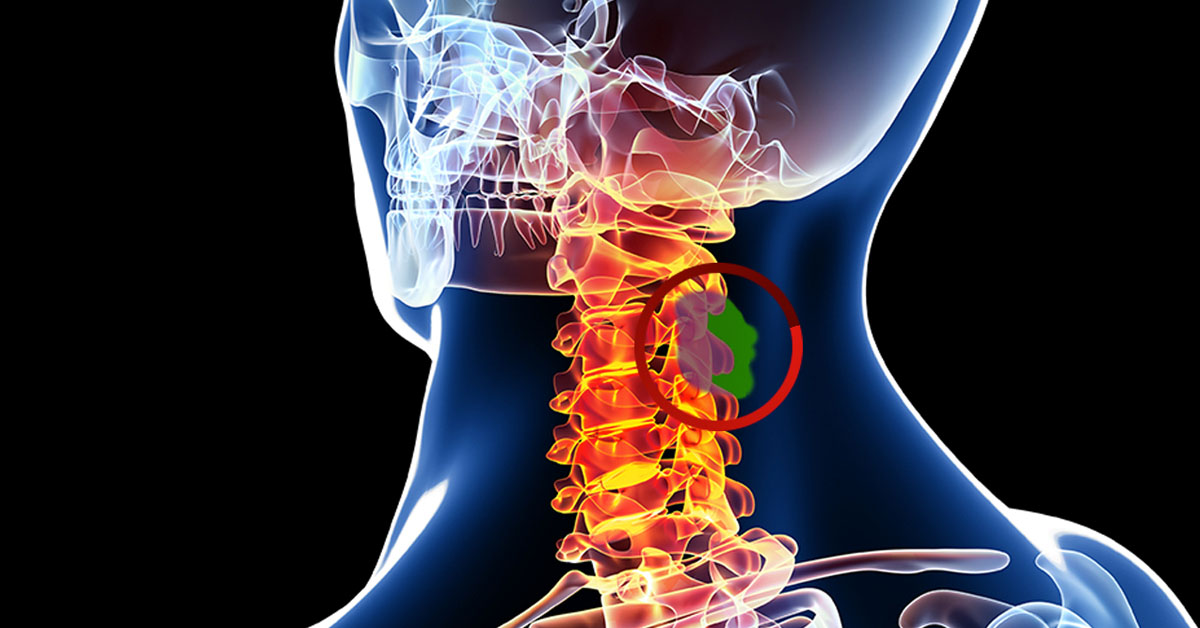Home | Conditions We Treat | Neck Pain
Neck Pain
The most common causes of neck pain are soft-tissue abnormalities due to injury or prolonged wear and tear.

What Is Neck Pain?
The neck (cervical spine) is composed of vertebrae which begin in the upper torso and end at the base of the skull. The bony vertebrae along with the ligaments (like thick rubber bands) provide stability to the spine. The muscles allow for support and motion. The neck has a significant amount of motion and supports the weight of the head. However, because it is less protected than the rest of the spine, the neck can be vulnerable to injury and disorders that produce pain and restrict motion. For many people, neck pain is a temporary condition that disappears with time. In rare cases, infection or tumors may cause neck pain.
What are the symptoms of a neck injury or disorder?
- Stiffness or difficulty moving the neck
- Pain that radiates to the shoulders, upper back, or arms
- Muscle spasms or tightness
- Headaches that start at the base of the skull
- Numbness, tingling, or weakness that radiates down the arms or hands
- Tenderness or knots
- Grinding or popping sensation when moving the neck
What Causes Neck Pain?
Degenerative diseases that cause neck pain include osteoarthritis and rheumatoid arthritis. Osteoarthritis usually occurs in older people as a result of wear of the joints between the bones in the neck. Rheumatoid arthritis can cause the destruction of the joints of the neck. Both of these major types of arthritis can cause stiffness and pain.
Degenerative and Inflammatory Diseases
Degenerative diseases that cause neck pain include osteoarthritis and rheumatoid arthritis. Osteoarthritis usually occurs in older people as a result of wear of the joints between the bones in the neck. Rheumatoid arthritis can cause the destruction of the joints of the neck. Both of these major types of arthritis can cause stiffness and pain.


Vertical Disc Degeneration
Discs act as a shock absorber between the bones in the neck. In cervical disc degeneration (typically age 40 onwards), the normal gelatin-like center of the disc degenerates, and the space between the vertebrae narrows. As the disc space narrows, added stress is applied to the joints of the spine causing further wear and degenerative disease. The cervical disc may also protrude and cause pressure on the spinal cord or nerve roots when the rim of the disc weakens. This is known as a herniated cervical disc.
Neck Injury
Because the neck is so flexible and because it supports the head, it is extremely vulnerable to injury. Motor vehicle or diving accidents, contact sports, and falls may result in neck injury. The regular use of safety belts in motor vehicles can help to prevent or minimize injury. A “rear end” automobile collision may result in hyperextension, a backward motion of the neck beyond normal limits, or hyperflexion, a forward motion of the neck beyond normal limits. Most common injuries are to the soft tissues, i.e., muscles and ligaments. Severe injury with fracture or dislocation of the neck may damage the spinal cord and cause paralysis (quadriplegia).

How Is Neck Pain Treated?
Most patients are treated successfully with rest, medication, immobilization, physical therapy, exercise, activity modifications, or a combination of these methods.
Neck Pain Due to Inflammation
For example, if the pain is caused by inflammation as a result of stretching muscles and ligaments beyond their limits, your orthopedist may prescribe rest and a neck collar for a specified period of time, as well as medication to reduce inflammation. If medication is prescribed to reduce pain, it should be used only as directed and should not be taken for extended periods of time. In addition, remember that if your orthopedist prescribes rest, it is vital that you follow instructions carefully.
Chronic Neck Pain
When neck pain persists or is chronic, your orthopedist may recommend a rehabilitation program that includes an exercise program and various types of physical therapy to help you relieve your pain and prevent it from coming back.
Surgery for Neck Pain
Very few patients require surgery to relieve neck pain. However, surgery may be necessary to reduce pressure on the spinal cord or a nerve root when pain is caused by a herniated disk or bony narrowing of the spinal canal. Surgery may also be required following an injury, to stabilize the neck and minimize the possibility of paralysis such as when a fracture results in instability of the neck.
Why Choose Synergy Health Partners?
Synergy Health Partners is Michigan’s only integrated musculoskeletal care provider, offering a comprehensive and coordinated approach to your well-being. We provide all specialty fields of musculoskeletal care under one umbrella, including urgent care centers staffed by orthopedic specialists, surgical and non-surgical treatments performed in-office or at our state-of-the-art ambulatory surgery centers, virtual consultations, and an in-house pharmacy for added convenience.
Frequently Asked Questions
When should I see a doctor for neck pain?
If severe neck pain occurs following an injury (motor vehicle accident, diving accident, fall), a trained professional, such as a paramedic, should immobilize the patient to avoid the risk of further injury and possible paralysis. Medical care should be sought immediately. Immediate medical care should also be sought when an injury causes pain in the neck that radiates down the arms and legs. Radiating pain or numbness in your arms or legs causing weakness in the arms or legs without significant neck pain should also be evaluated.
If there has not been an injury, you should seek medical care when neck pain is:
- Continuous and persistent
Severe - Accompanied by pain that radiates down the arms or legs
- Accompanied by headaches, numbness, tingling, or weakness
How is neck pain diagnosed?
Determining the source of the pain is essential to recommend the right method of treatment and rehabilitation. Therefore, a comprehensive examination is required to determine the cause of neck pain.
Your orthopedist will take a complete history of the difficulties you are having with your neck. He or she may ask you about other illnesses, any injury that occurred to your neck, and any complaints you have associated with neck pain. Previous treatment for your neck condition will also be noted.
Next, your orthopedist will perform a physical examination. This examination may include an evaluation of neck motion, neck tenderness, and the function of the nerves and muscles in your arms and legs.
X-ray studies often will be done to allow your orthopedist to look closely at the bones in your neck. These simple diagnostic techniques often help orthopedists to determine the cause of neck pain and to prescribe effective treatment.Patients who require further evaluation may undergo one or more of the following examinations:
- MRI (magnetic resonance imaging). This non X-ray study allows an evaluation of the spinal cord and nerve roots.
- CT (computed tomography). This specialized X-ray study allows careful evaluation of the bone and spinal canal.
- Myelogram (injection of a dye or contrast material into the spinal canal). This specific X-ray study also allows careful evaluation of the spinal canal and nerve roots.
- EMG (electromyogram). This test evaluates nerve and muscle function.
Your orthopedist may supplement your evaluation with blood tests, and, if necessary, will consult with other medical specialists.
Get Relief From Neck Pain
Chronic neck pain can be debilitating, limiting your daily activities and diminishing your quality of life. At Synergy Health Partners, our team of experienced specialists understands the complexities of neck pain and is dedicated to providing comprehensive care tailored to your unique needs.
